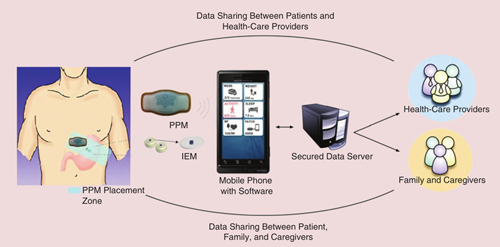
A Digital Health Solution for Using and Managing Medications
A Digital Health Solution for Using and Managing Medications
By Lorenzo DiCarlo, Greg Moon, Allison Intondi, Robert Duck, Jeremy Frank, Hooman Hafazi, Yashar Behzadi, Timothy Robertson, Ben Costello, George Savage, and Mark Zdeblick
NOTE: This is an overview of the entire article, which appeared in the September/October 2012 issue of the IEEE Pulse magazine.
Click here to read the entire article.
Several approaches are currently used to assess medication taking. The most reliable method is directly observed therapy (DOT), which consists of a clinician observing and documenting the date and time of the patient’s swallowing each dose of medication. In some cases, this is done by video recording of the patient taking the medication. Although highly reliable when performed appropriately, this method is resource intensive, time consuming, and costly. Indirect methods (such as patient questionnaires, and patient pill diaries) are limited in scope and have been shown to be inaccurate.
For this reason, researchers at Proteus Digital Health, Inc. have developed a digital health technology that determines when medications have been ingested and can wirelessly provide this information in a confidential way to patients and designated caregivers, health providers, and researchers (Figure 1).

Figure 1. Overview of the system for wirelessly observed therapy. Data that are collected and
stored by the system can be accessed by patients and others who are designated by the patient.
The system consists of an ingestible sensor, the Ingestible Event Marker (IEM), and an externally worn adhesive monitor, the Proteus Personal Monitor (PPM). Together, the IEM and PPM can be used to directly confirm whether, when, or how many doses of prescribed medication are actually taken and can provide information related to activities of daily living.
The IEM is approximately the size of a grain of sand and is composed of materials that are safe to be ingested. The IEM can be incorporated with medication in several ways during manufacturing: within a tablet, on the surface of a tablet with a transparent or an opaque-colored covering, or inside a capsule. When the IEM is ingested, it combines the electrolyte coating on its surface with the electrolytes found in the stomach fluid to form a biogalvanic battery. The ensuing current is modulated by the IEM and creates an electric field that propagates through the body tissues to the skin surface. When the current reaches the skin surface it is detected, decoded, recorded, and date- and time-stamped by the adhesive monitor, which acts as a receiver. In this manner, the body becomes the battery electrolyte, and it becomes the antenna for the IEM to communicate to the sensor on the torso.
The PPM is a miniaturized, ambulatory, battery-operated data-logging device that has been designed for seven-day wear during any and all daily activities, including bathing and swimming. In addition to detecting when an IEM has been ingested, the PPM can record biometrics, such as heart rate, activity, and sleep and sleep quality. The PPM also assesses skin impedance to confirm that the PPM is attached properly to the skin of the user.
Before the PPM is first applied to the skin, it is activated pressing and holding a button that brings the device out of storage mode and begins regular operation. The activated PPM brings together various data streams from different sensors, which are then processed and stored. When the PPM comes into proximity of the patient’s mobile phone, the PPM’s stored by its data are encrypted and transmitted via Bluetooth to the patient’s phone, and the phone sends the data using industry-standard encryption utilized by banks to a secured, centralized data center for storage and processing. Processed data are then relayed for display to the patient. Some or all of the processed data may also be relayed to other individuals, including medical professionals, as designated by the patient.
The article contains photos of the IEM and the PPM device, along with a report on a feasibility study conducted by Proteus Digital Health, showing the performance of the system.
ABOUT THE AUTHORS
Lorenzo DiCarlo (ladicarlo@proteusbiomed.com), Greg Moon, Allison Intondi, Robert Duck, Jeremy Frank, Hooman Hafazi, Yashar Behzadi, Timothy Robertson, Ben Costello, George Savage, and Mark Zdeblick are with Proteus Digital Health Incorporated, Redwood City, California.






